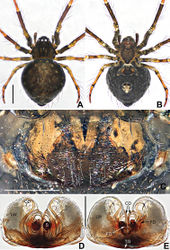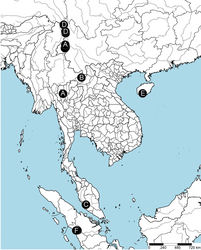Coddingtonia huifengi
| Notice: | This page is derived from the original publication listed below, whose author(s) should always be credited. Further contributors may edit and improve the content of this page and, consequently, need to be credited as well (see page history). Any assessment of factual correctness requires a careful review of the original article as well as of subsequent contributions.
If you are uncertain whether your planned contribution is correct or not, we suggest that you use the associated discussion page instead of editing the page directly. This page should be cited as follows (rationale):
Citation formats to copy and paste
BibTeX: @article{Feng2019ZooKeys886, RIS/ Endnote: TY - JOUR Wikipedia/ Citizendium: <ref name="Feng2019ZooKeys886">{{Citation See also the citation download page at the journal. |
Ordo: Araneae
Familia: Theridiosomatidae
Genus: Coddingtonia
Name
Coddingtonia huifengi Feng & Lin, 2019 sp. nov. – Wikispecies link – ZooBank link – Pensoft Profile
Type material
Holotype ♀, paratypes 2♂ and 28♀ (NHMSU) INDONESIA: Kanagarian Matuailia, environs of Batang Lawang Cave, 0°15.74'S, 100°18.49'E, ca. 760 m, 12 Jan. 2014, H. Zhao leg. Two paratypes 1♂ and 1♀ used for sequencing, same data as for preceding, GenBank: MN211315 and MN211314; 1♂, 2♀ (NHMSU) Sumatra, West Sumatra Province, Kab Agam TaBik Simarasok Village, Jorong Koto tuo, 0°14.90'S, 100°28.99'E, ca. 710 m, 11 Jan. 2014, H. Zhao leg.
Etymology
The new species is named after Dr Huifeng Zhao who extensively collected spiders from Southeast Asia.
Diagnosis
The male of this new species differs from the male of C. euryopoides by the median apophysis with a distal flexible hook, and the narrower, shorter conductor (Fig. 3A, D); in other similar species the tip is straight and wider and conductor is longer (see Labarque and Griswold 2014[1]: figs 1C, 5D–F). The female can be distinguished from the other five species by having 3 coils (one thick, two thin) of copulatory ducts (Fig. 2F), whereas they are fewer or more in other species. Moreover, C. huifengi differs by the lack of a posterior tubercle on the abdomen (Fig. 2A–D) vs. present in C. euryopoides, C. erhuan sp. nov., and C. lizu sp. nov. (Figs 1A–C, 4A–C, 5A, B).
Description
Females (holotype). Carapace nearly pentagonal, dim yellowish, cephalic area moderately raised. Anterior eye row precurved, posterior eye row straight. Sternum heart-shaped, grey yellow, with sparse setae. Mouthparts brown. Femora and patellae dim yellow, other segments brown. Abdomen round, dorsally grey, ventrally deeper, bears sparse long hairs, weakly ossified at hair base (Fig. 2A, B). Measurements: total length 2.13. Carapace 1.02 long, 0.97 wide. Clypeus 0.15 high. Sternum 0.48 long, 0.46 wide. Abdomen 1.41 long, 1.35 wide. Length of legs: I 2.78 (0.85, 0.30, 0.73, 0.50, 0.40); II 2.66 (0.84, 0.23, 0.71, 0.47, 0.41); III 1.79 (0.56, 0.16, 0.45, 0.35, 0.27); IV 2.35 (0.79, 0.21, 0.58, 0.43, 0.34).
Epigyne (Fig. 2E–G): epigyne covered with sparse black setae in the central region; with deep central pit and 2 longitudinal grooves close to lateral margins of the plate. Spermathecae barely visible through the integument; LW well developed, like a pair of boxing gloves, swollen sacks with dorso-median glandular ducts; spermathecae globular, separated by one radius; copulatory ducts form an expanded posterolateral loop, and coiled into 2 slender posteromedian loops, finally connecting ventrally on the spermathecae; fertilization ducts arise from the dorsomesal the spermathecae.
Male (one paratype): Somatic features as in Fig. 2A, B and coloration slightly darker than in female. Measurements: Total length 1.87. Carapace 0.98 long, 0.93 wide. Clypeus 0.16 high. Sternum 0.46 long, 0.45 wide. Abdomen 0.92 long, 0.89 wide. Length of legs: I 2.33 (0.73, 0.24, 0.61, 0.40, 0.35); II 2.09 (0.66, 0.19, 0.53, 0.39, 0.32); III 1.54 (0.48, 0.15, 0.35, 0.30, 0.26); IV 1.90 (0.61, 0.20, 0.45, 0.36, 0.28).
Palp (Fig. 3A–D): tibia small, cymbium narrow, about 2 times longer than width, with long setae; paracymbium short and small, about of 1/5 cymbial length; tegulum capacious; median apophysis lamellar, subrectangular; conductor disk shaped with a needle-like distal process; mesal bristle of the embolic apophysis describes a semi-loop above the tegulum and cymbium; embolus long, whip-like, extending far beyond the mesial embolic apophysis and coiling into one loop.
Distribution
Known only from the type locality (Fig. 6).
Original Description
- Feng, C; Lin, Y; 2019: Three new species of the genus Coddingtonia from Asia (Araneae, Theridiosomatidae) ZooKeys, 886: 113-126. doi
Images
|
Other References
- ↑ Labarque F, Griswold C (2014) New ray spiders from Southeast Asia: the new Philippine genus Tagalogonia gen. nov. and continental genus Coddingtonia Miller, Griswold and Yin, 2009 (Araneae: Theridiosomatidae), with comments on their intergeneric relationships. In: Williams G Gosliner T (Eds) The Coral Triangle: The 2011 Hearst Philippine Biodiversity Expedition.California Academy of Sciences, San Francisco, 407–425.





